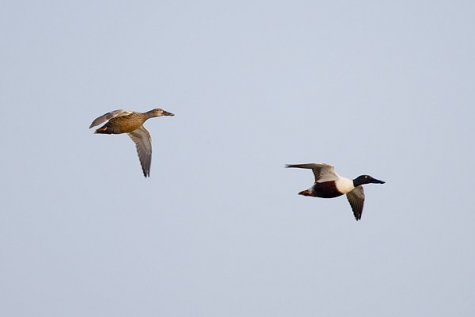Shore ducks
Photo:Arne Ader
Translation: Liis
Shoveller ducks
Shoveller; Northern shovellerLuitsnokk-part or luitsnokk Anas clypeata
Inland we meet shoveller ducks rather rarely, if anywhere, then at the Võrtsjärv shores or the Emajõe flood plains. They breed on the seaside meadows at the coastal sea, and with the decline in the number of eiders, now also on the small isles. There are not many of them in Estonia, 1000 to 1500 breeding pairs.
From a distance they can be confused with the considerably larger shelducks, but there both sexes have similar plumages. The male shoveller has a somewhat similar look; if his mate is "duck brown“ we have to do with shovellers; they weigh over half a kilo.
And of course the large beak, reminding of a spoon and relating to the bird’s name: on swimming it is in the water nearly all the time, an efficient working tool for getting food. Dabbling ducks forage in shallow, food-rich waters. The birds pump water past strips placed at the beak edges and as a result various kinds of food stay in the beak and are then swallowed. Often the birds feed together: so more suspended matter rises from the bottom, and the mouthfuls will be more effective.
The male bird or drake has a blackish-green head, white chest, rust-brown belly and black-and-white hind parts. The wing speculum is green with a broad white edge, wing undersides white. As already said the female is duck brown with slightly lighter belly, wing undersides whitish, and the wing coverts bluish grey.









